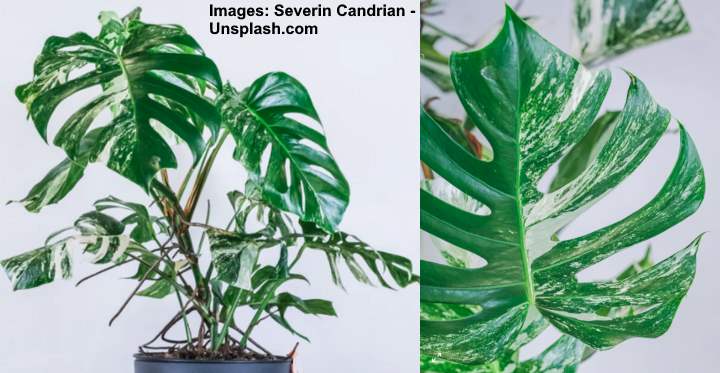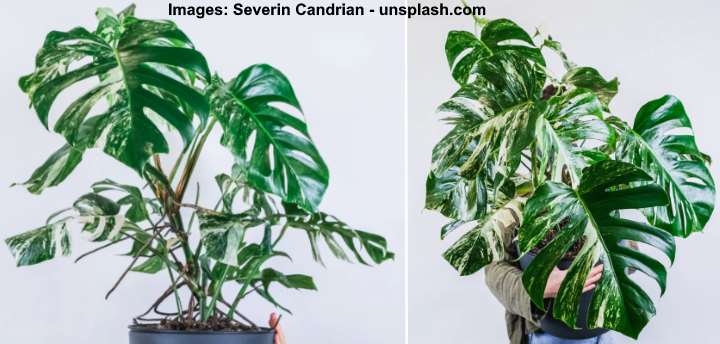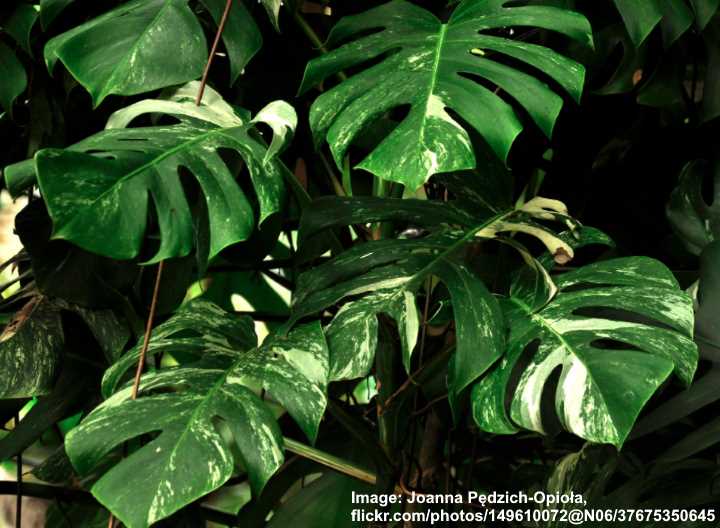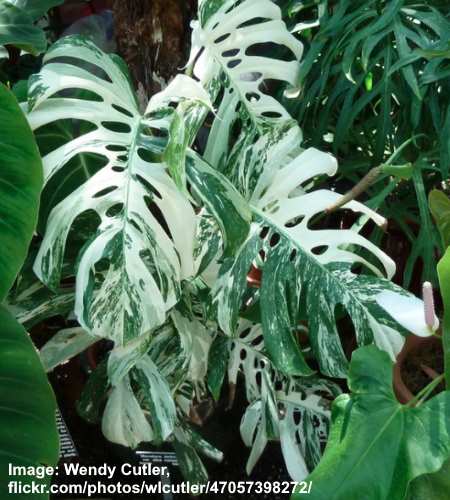Monstera Deliciosa Albo Variegata: The Variegated Monstera – Care Guide

The Monstera deliciosa ‘Albo Variegata’ is a spectacular type of variegated Swiss cheese plant with large dark green and brilliant white leaves. The Monstera ‘Albo Variegata’ is both a rare and expensive houseplant. Looking after this exotic green-white variegated Monstera is tricky. The Monstera Variegata is a slow-grower and needs more light to grow so that it can photosynthesize properly.
There is a lot of interest in variegated Monstera plants. The Monstera ‘Albo Variegata’ is considered highly sought after and one of the most expensive plants because pure white leaf variegation is extremely rare in nature. Additionally, it is also challenging to propagate. However, after seeing pictures of a white variegated Monstera, it’s easy to appreciate the visual appeal of this Swiss cheese plant.
This article is a guide to caring for the Monstera deliciosa ‘Albo Variegata.’ You will also find out what it takes to grow a large split-leaf variegated Monstera plant.
What is Monstera Albo (Monstera Albo Variegata)

Monstera deliciosa ‘Albo Variegata’
The ‘Monstera Albo’ variegated plant is the Monstera deliciosa—a huge tropical flowering plant native to Central and South America. The variegated ‘Monstera Albo’ characteristics are large glossy heart-shaped leaves. The white and green variegated leaves can grow between 10” and 35” (25 – 90 cm) long and up to 30” (75 cm) wide.
Most people grow the Monstera ‘Albo Variegata’ as a tropical houseplant. Growing indoors in pots, the vining leathery-leafed plant grows between 6.5 and 10 ft. (2 – 3 m) tall. Young Monstera deliciosa plants don’t have the characteristic lobed leaves. The lobes and holes develop slowly with age.
The Monstera deliciosa Variegata is easily recognizable due to its white patterns on the heart-shaped lobed leaves. Some of the dark-green shiny leaves have white marks that look like splashes of creamy-white paint. The most spectacular variegated monstera plants have leaves that one half is entirely snow-white.
The botanical name Monstera deliciosa means “monstrous,” referring to the plant’s size, and “delicious,” referring to the edible fruit that the monstera produces.
As a type of epiphyte plant, the Monstera deliciosa has aerial roots. These long stem-like growths absorb moisture and nutrients from the surroundings.
Although it rarely happens, the ‘Monstera Albo’ flowers. Like all plants in the arum family Araceae, the flowers are spathe-like with a white spadix flower. Monstera deliciosa flowers grow between 4” and 6” (10 – 15 cm) high.
Apart from the Swiss cheese plant, other common names for Monstera deliciosa include fruit salad plant, monster fruit, Mexican breadfruit, and split-leaf philodendron. It’s good to remember that Monstera and Philodendron are two separate species of plants.
What is Variegated Monstera?

Leaf variegation on monstera deliciosa ‘Albo Variegata’
The ‘Monstera Albo’ with its creamy-white and green lobed leaves is the result of variegation. The leaves of variegated plants have different colored zones in the leaves. This can look like irregular patterns, or a whole section of the leaf can be a different color. With the Monstera deliciosa ‘Albo Variegata,’ the main variegation color is white.
True variegation rarely happens in nature. However, it can occur naturally in tropical rainforests, where many tropical houseplants come from.
Variegation occurs because green pigments called chlorophyll are lacking in the plant tissue. This can happen due to cell mutation. There are two types of variegation. One is inherited (genetic) variegation, and the other occurs randomly (chimeric). With inherited variegation, the plant’s cells contain the two types of tissue needed for true variegation.
Variegated plants, including ‘Monstera Albo,’ that have genetic variegation, keep the mutation in the plant’s DNA. This means that you can propagate green shoots or seeds from these plants. The white variegation then appears in new variegated ‘Monstera Albo’ plants.
Monstera plants that have variegation due to random mutations are more difficult to propagate. Usually, the propagated stems are weaker, and the new plants eventually die because they lack enough chlorophyll.
Can a regular monstera become variegated? Random variegation in nature is extremely rare. The chance of your regular Monstera deliciosa becoming a variegated ‘Monstera Albo’ is about 1 in 100,000. It is more likely that a randomly variegated monstera loses its variegation and its leaves become green.
Other reasons why variegation can revert and turn completely green are low light, temperature extremes, or because part of the plant produces too much chlorophyll.
Suppose you think you spot variegation appearing on a regular Monstera deliciosa. In that case, it is more likely a disease or other condition affecting your houseplants.
Why the Variegated Monstera Albo is Hard to Find

Variegated monstera deliciosa is a rare and expensive houseplant
The Monstera Deliciosa Variegata is one of the rarest and sought-after houseplants. Additionally, white variegated monstera plants are challenging to propagate. The ‘Monstera Albo’ has creamy-white variegation due to less chlorophyll. This means that the monstera grows slower and requires more skill to develop into a mature plant.
Why Are Variegated Monsteras So Expensive?
Because of high demand and their rarity, variegated monstera plants can fetch eye-watering prices. It’s not uncommon for rooted leaf cuttings of variegated Monstera deliciosa and Monstera borsigiana to sell for hundreds of dollars. Whole monstera plants with white and green leaves can sell for thousands of dollars.
How To Find a Variegated Monstera
The easiest way to buy a stunning ‘Monstera Albo’ plant is to look online. There are many social media groups dedicated to variegated monstera plants. Also, websites such as Etsy and eBay and some online plant stores sell variegated plants or rooted leaf cuttings.
When looking for a suitable white variegated monstera to buy, make sure that there is some white and green on the stem and leaf. It’s best to avoid leaf cuttings that are all white. Although they look stunning, the plant will have difficulty growing due to a lack of chlorophyll.
Other types of Variegated Monstera

There are other types of variegated monstera plants with variegation of green, white, cream, yellow and lime
What if you are keen to buy a variegated monstera but can’t afford a ‘Monstera Albo’? In that case, there are other types of monsteras with fascinating variegation on their leaves. Here are a few variegated monsteras that are worth considering.
Monstera borsigiana: A variegated Monstera borsigiana has smaller leaves and a faster growth rate than the Monstera deliciosa. The Monstera borsigiana ‘Albo’ has lobed leaves and creamy white variegation, just like a smaller—and cheaper—version of the Monstera deliciosa ‘Albo.’
Monstera deliciosa ‘Thai Constellation’: The ‘Thai Constellation’ monstera has light white to yellow speckled variegation. As the plant matures, whole leaf lobes can develop yellow or white colors.
Monstera deliciosa ‘Aurea’: The variegated monstera ‘Aurea’ is from the deliciosa species and has golden lime-yellow variegation on dark green lobed leaves.
How to Care for Monstera deliciosa ‘Albo Variegata’
To care for Monstera deliciosa ‘Albo Variegata,’ grow the white variegated monstera plant in bright, indirect sunlight. Plant the ‘Monstera Albo’ in aerated, well-draining potting soil and water the monstera when the soil partially dries. Grow in even temperatures between 65°F and 80°F (18°C – 27°C) with relatively high humidity.
Let’s look in more detail at how to care for ‘Monstera Albo’ to keep its vibrant variegation.
Monstera Albo Light Requirements

Grow Monstera Deliciosa Albo Variegata in indirect light
A variegated monstera such as the ‘Monstera Albo’ thrives in indirect bright light. You can promote variegation by keeping the monstera near a window but behind a sheer curtain on south-facing windows. Leaf variegation may fade if the monstera grows in low-light conditions. You can also use artificial light to boost variegation.
To ensure your ‘Monstera Albo’ thrives, protect it from direct sunlight. The white leaf areas tend to burn faster in direct, intense sunlight.
The Best Soil for Growing Variegated Monstera Houseplants
Monstera deliciosa ‘Albo Variegata’ is an epiphytic plant that grows in loose, aerated soil with excellent drainage. Mix one part regular houseplant soil, one part orchid bark, and one part perlite for drainage to create the best potting mix for an indoor variegated monstera.
Monstera plants need to grow in a chunky monstera soil mix that holds enough moisture without becoming soggy. Waterlogged soil causes roots to rot quickly—not something you want to happen with an expensive ‘Monstera Albo.’
Related reading: The best DIY houseplant soil recipes.
How to Water Monstera deliciosa ‘Albo Variegata’
Water a ‘Monstera Albo’ as often as the potting mix dries out. Ideally, wait until the top 2” or 3” (5 – 7.5 cm) is dry before you water the plant. You may have to water the Monstera deliciosa as often as once a week in the growing season. Hold back watering in winter and only water when the soil is dry.
The proper way to water houseplants such as ‘Albo Variegata’ is to soak the soil thoroughly. Wait until the excess water drips from the pot’s drainage holes before placing back on the tray. This watering technique of drench and dry prevents roots from sitting in soggy soil, and it provides enough hydration.
Monstera deliciosa ‘Albo Variegata’ Temperature Requirements
‘Monstera Albo’ thrives in temperatures between 65°F and 80°F (18°C – 27°C). Ensure that your exotic houseplant doesn’t stand in cold drafts or near hot air vents. The swings in temperature can stress the plant and may even cause the variegation to revert. The minimum temperature for a variegated monstera is 50°F (10°C).
Humidity Needs to Grow White Variegated Monstera Indoors
Monstera deliciosa ‘Monstera Albo’ prefers relative room humidity at around 60 percent. Variegated monsteras have higher humidity requirements than regular, all-green monsteras. You can increase humidity by putting the monstera pot on a pebble tray half-filled with water. Top up the tray regularly to ensure adequate air moisture levels.
Misting leaves of a variegated monstera isn’t necessary because it doesn’t provide enough humidity. However, to care well for the white and green variegated leaves, you can use a damp cloth to wipe the leaves once a week.
‘Monstera Albo Variegata’ Growth Rate
Variegated monsteras such as the Monstera deliciosa and Monstera borsigiana grow slowly. The white leaf variegation means there is less chlorophyll for photosynthesis. A Monstera deliciosa will grow faster in bright light and occasional watering.
The maximum growth is usually 6.5 – 10 ft. (2 – 3 m) in ideal indoor conditions. However, it may take many years for a ‘Monstera Albo’ to reach mature height.
How to Fertilize Monstera deliciosa ‘Albo Variegata’
Use a diluted balanced houseplant fertilizer once a month to keep your ‘Monstera Albo’ healthy. Start applying a 20-20-20 NPK fertilizer diluted to half strength in spring. Apply every four weeks until the end of summer. In fall and winter, hold off fertilizing as the plant growth becomes dormant.
Pruning Monstera Albo Variegata
Pruning a variegated monstera is necessary to keep balanced variegation. If pure white or pure green leaves start to grow, you’ll need to prune them off. Starting from the vine’s tip, look for the leaves with balanced variegation—an even combination of white and green. Trim the vine to this point to keep growth healthy.
How to Propagate Monstera deliciosa ‘Albo Variegata’
Monstera deliciosa propagation is by stem cuttings. Propagating a variegated monstera is an excellent way to grow more exotic monsteras with white and green leaves.
To propagate a monstera, take a node cutting. This should be the entire length of the leaf stem and part of the vine. You should also make sure there is an eye-like mark on the stem near the vine. This is where the new plant will grow from.
To grow a new variegated monstera, place the stem cutting in a jar of water to root. After a few weeks, new white roots should appear. You can then transfer the rooted cutting to a pot filled with the appropriate potting soil.
Alternatively, you can place the cutting straight into the soil to take root. If you do this, secure a plastic bag over the pot to increase humidity and keep the soil moist. After a few weeks, the newly propagated ‘Monstera Albo’ will be ready to repot.
How to Repot Variegated Monstera Albo
In time, it’s necessary to transfer a variegated monstera to a larger pot. Signs that it’s time to repot include roots poking out of the container, slow growth, and poor water flow when you water the plant. Choose a larger pot that is one or two sizes larger than its current one.
If your ‘Monstera Variegata’ needs support, choose a heavier terracotta pot that will provide support for the moss pole and large white and green monstera leaves.
Is Monstera deliciosa ‘Albo Variegata’ Toxic?
Monstera plants, including the ‘Monstera Albo,’ are poisonous to cats and dogs. The ASPCA says that Monstera deliciosa contain toxic insoluble calcium oxalates. Ingesting parts of monstera plants can result in oral irritation and burning, vomiting, and difficulty swallowing.
Doctors also say that the Swiss cheese plant can also cause burning and pain in the mouth and swelling if humans ingest the plant.
Pests Affecting Monstera Albo Variegata Growth
Spider mites, mealybugs, and thrips are common houseplant pests that can destroy a beautiful white variegated monstera. Make a neem oil solution by mixing 2 tsp. neem oil, 1 tsp. dish soap, and a quart (1 l) of water in a spray bottle. Thoroughly douse both sides of the white and green foliage with neem oil to get rid of bugs. Use once a week for best results.
Related reading: The benefits of neem oil for houseplants.
Diseases Affecting Variegated Monstera Houseplants
Root rot is a disease affecting variegated monstera plants if you overwater them. Too much soil moisture causes roots to decay and turn mushy. This starves the variegated plant of essential nutrients. It also causes fungal diseases.
To prevent root rot, only water ‘Monstera Variegata’ when the top layer of soil is dry. Monsteras are more forgiving of underwatering rather than overwatering.
If you notice that stems near the soil line are becoming brown and mushy, you should repot the plant to change the soil and inspect the root damage. Trim off any decaying roots before repotting. If root damage is extensive, you may have to take leaf cuttings from the healthy part of the monstera vine to propagate new, healthy plants.
FAQs — Variegated Monstera Care
The essential care requirement to keep a variegated monstera plant vibrant and healthy is to give it enough sunlight. However, there can be a few other issues that can affect Monstera deliciosa Variegata’s growth.
How often does Monstera grow new leaves?
Typically, monstera plants produce new leaves every four to six weeks during the growing season. However, variegated monstera plants usually grow slower than the traditional varieties. So, depending on growing conditions, you may only get a few new leaves every year.
If you don’t see new growth, it’s vital to be patient. Make sure that your variegated monstera gets enough sunlight and water it when the soil partially dries.
Why is my Monstera Albo not splitting?
Monstera deliciosa ‘Albo Variegata’ leaves take time to split. Young leaves are heart-shaped without any splits or lobes. Due to its slower growth, variegated monstera leaves take longer to split than regular monstera plants.
For monstera leaves to develop the characteristic Swiss cheese plant look, they need specific growing conditions. First, you should keep your variegated monstera plants in a warm, bright room but protected from direct sunlight. Second, it’s vital to water the plant occasionally, just enough to keep the roots moist but never soggy. Third, you need plenty of patience.
Should I cut off brown Monstera leaves?
It’s a good idea to trim off any monstera leaves that start to yellow and become brown. Apart from improving its appearance, removing unhealthy leaves helps prevent plant infection and concentrates energy into growing healthy foliage.
Related articles:
